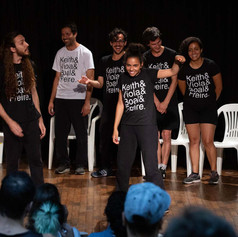Impro in Brazil: The Physics of Play
- Theresa Robbins Dudeck
- Nov 13, 2019
- 6 min read
“I used to enjoy physics. Why did I enjoy it? I used to play with it…. So I got this new attitude. Now that I am burned out and I’ll never accomplish anything, I’m going to play with physics, whenever I want to, without worrying about any importance whatsoever. Within a week I was in the cafeteria and some guy, fooling around, throws a plate in the air…. I had nothing to do, so I start figuring out the motion of the rotating plate…. It was effortless. It was easy to play with these things. It was like uncorking a bottle: Everything flowed out effortlessly. I almost tried to resist it! There was no importance to what I was doing, but ultimately there was. The diagrams and the whole business that I got the Nobel prize for came from that piddling around with the wobbling plate" ~ Richard Feynman, c. 1945
(Surely You’re Joking Mr. Feynman: Adventures of a Curious Character, 1985)
Play is powerful. Play needs to be integrated into education, into work environments. Keith Johnstone reminded me of Feynman’s rotating/wobbling plate story when we talked a few weeks ago. I was reminded of this story again on 31 October when we conference-called Keith into the IMPROLab Festival at UFMG. He declared to the group of almost 60 students and professors packed into a very small and hot room that learning should be fun. That you should want to go to school in the morning and not want to leave when the dismissal bell rings in the afternoon. After Feynman’s work at Los Alamos on the Manhattan Project ended, he was offered a professor position at Cornell. He was burnt out and he had recently lost his wife to tuberculosis, but teaching and the students, for Feynman, kept “life going.” Still, he wasn’t excited or curious about physics anymore, because at Los Alamos, it wasn’t play, it was building an atomic bomb in the midst of WWII! But when Feynman made up his mind to "play" with physics and do whatever he liked, when he took the pressure off himself to invent or discover something original, physics became effortless and…he won the Nobel prize!
The IMPROLab Festival the Teatro department at UFMG (Federal University of Minas Gerais) hosted the week of 28-31 October was a good example of effortless, fun learning! The first evening, I facilitated a 3-hour Impro System master class for an audience of around 45 and with 14 of my IMPROLab players on the stage working with me. It is always difficult for me to simply “show and tell,” so I insisted the audience members play Blind Offers/Justify the Gesture warm-up and respond with “applause, hmm, or boo” when we played What Comes Next? by committee. Professor Mariana Muniz and Anna Starling (a student from my Thursday class) translated, and Mariana jumped in as an improviser occasionally, which is always a treat! I structured the class to move from Giving/Accepting Offers to Status to Narrative. More of a sampling of the Impro System than a deep dive, but it was informative and entertaining and an opportunity for my IMPROLab players to demonstrate skills they had been working on since August for an audience.
On Tuesday night of the festival, we did MAESTRO! Mariana and I co-directed 14 players, thirteen from the IMPROLab and our guest professor from Argentina, Javier “Griego” Falcón, who taught a master class on the role of the director in impro. It was one of the best Maestros I’ve ever witnessed. The players were so generous. They had been working together since August and the trust between them was evident. Mariana and I worked together fluidly. Such a joy working alongside her! And the 2-hour event had great variety: tilts, gibberish, maximum status gaps, master/servant, blind offers, gibberish, staying with it, clowning, humor, pathos, balloons, hats, music-inspired scenes, an “Again!” moment, and even a 4-person lazzo! Kelly was crowned our Maestro, to everyone’s gratification.
On Wednesday night, Mariana facilitated a clowning class/demo with the professional clowns (several from IMPROLab) that make up the group Trampulim followed by a bit of mask work with Rafael and his Balinese masks (I wrote about Rafael’s mask show, Patuscada, in the September 30th blog post). All of these folks have worked with Mariana over the years and so impro is integrated into their processes. Johnstone's Hat Game, when played by the clowns, seemed like Feynman’s decoding of the rotating plate, that is, effortless but with a heightened sense of play and curiosity. Rafael’s improvised mask work, with Mariana side-coaching, was hypnotic. Again, it seemed effortless because with a master teacher like Mariana guiding him and with the pressure “to perform” eliminated (this was a public class, not a performance), he could simply play!
On Thursday afternoon, we set up a Zoom call with Keith. Unfortunately, the video on Keith’s end did not work, but we all heard his voice loud and clear as he answered questions we gathered earlier from the students. One of the questions proposed was, “Do you see some kind of connection between your work and Asian philosophy, for example, Zen Buddhism?” I reminded Keith of a book he often refers to, Zen in the Art of Archery (1953) by Eugen Herrigal, and he responded:
“In Japanese culture, the court culture was very rigid. Everyone knew their place. In reaction, they developed forms to exercise spontaneity in the arts [pottery, archery, etc.], they all had an improvisational approach. I personally think Zen in the Art of Archery is a very funny book. Herrigel has a Zen teacher of archery and the teacher keeps telling him that he mustn’t fire the arrow, that the arrow must fire itself. It makes no sense to him. Finally the master bows and says, ‘It fired,’ meaning the arrow fired. Herrigel jumps up and down and says, ‘I did it, I did it!’ And then the teacher won’t teach him anymore for weeks [laughter from students]. In the martial arts, reaction speed is quicker than a decided speed. So with Hat Games, if you think, ‘I’ll take the person’s hat,’ it’s too slow. But if you react, you’ll be much faster.
It’s about Zen mindfulness” ~ Keith Johnstone
In the biography on Keith, I go into some detail about how Keith has integrated the Zen teachings into his methodology. The connection I’m attempting to make in this blog is that if we want learning to be fun and to feel effortless, if we want our students and employees to collaborate and innovate with enthusiasm, we need to give them permission to “not think” and to play! In the introduction to Zen in the Art of Archery, D.T. Suzuki wrote:
“Man is a thinking reed but his great works are done when he is not calculating and thinking. ‘Childlikeness’ has to be restored with long years of training in the art of self-forgetfulness.
When this is attained, man thinks yet he does not think….” (viiii-ix)
I have a charismatic engineering student in my Impro for Leading, Collaborating, and Creating class and last Thursday, at the end of class, he said to me something like: “I don’t understand why my 3-hour engineering class seems to last forever and I only understand fragments of what is said by the professor. But in your class, the time goes by in an instant and it is fun and so much of what we learn is relevant to what I do.” I was beyond grateful for this comment, as you can imagine.
Keith introduced me to Richard Feynman’s book in San Francisco in 2009. We were at a bookstore together near BATS (Bay Area Theatresports) and a used copy of this book was on the shelf. Keith recommended that I buy it. About a quarter of my library now consists of books recommended by Keith, but Feynman’s is still my favorite. For one, I always have something to talk about with physicists. For instance, the guest cottage I am residing in is owned by a physicist who specializes in nano-technology and chaos theory. He is a retired UFMG professor and continues to work daily in his on-campus lab, where Feynman’s portrait hangs in the hall. For him, and I imagine for physicists around the world, Feynman’s lectures are masterpieces because they are enjoyable, accessible, and they get to the point. It is because of educator/philosophers like Feynman and Johnstone and Paulo Freire that I strive to create a classroom experience that engages the students through embodied learning and play.
I also want to mention that the culture must support teachers and managers to create this type of playful learning environment. At Cornell, Feynman was given permission to not worry about what he was doing or not doing. “When we hire a professor, we’re taking all the risks,” said the head of the laboratory. “If it comes out good, all right. If it doesn’t too bad.” In a way, this is like Keith telling Maestro players that if a scene fails, it is the fault of the directors, releasing the players from the pressure to “get it right.” Imagine if the University of Calgary had given this kind of support to Keith? What would the UofC drama department look like now?
The conversation with Keith and the students ended with one final ask from me: “Keith, any final ‘average’ idea to share with us?” (I've learned, from Keith, never to ask for a "great" idea. Set the bar low and be pleasantly surprised!). “Yes,” he said, “It should be play and not work.” I followed that with, “Even education, yes?” To which Keith immediately replied, “Well yeah! Sure. You can teach anything if it’s a game.”
(Photos by Dale Dudeck)

























Comments